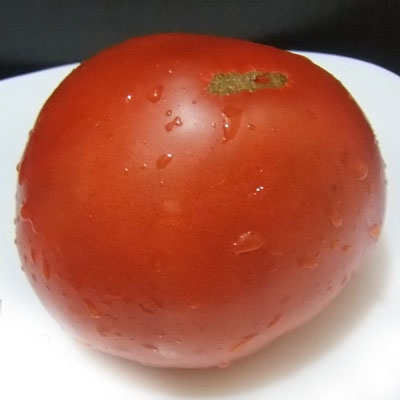
- Authors: Russia, Minusinsk, Krasnoyarsk Territory
- Category: grade
- Growth type: indeterminate
- Appointment: universal
- Ripening period: early
- Growing conditions: for open ground, for greenhouses
- Bush size: tall
- Bush height, cm: up to 250
- Ripe fruit color: pink
- Fruit shape: rounded
One of the famous Minusinsk tomatoes is an indeterminate universal variety Minusinsky giant. The tomato is recommended for cultivation in glass, film and polycarbonate greenhouses, in the southern regions it can be grown outdoors. The variety is used for fresh consumption, in summer and winter salads, sliced, vegetable stews, as well as for cooking juices, sauces, tomato paste and canning in pieces.
Breeding history
The variety appeared thanks to the efforts of breeders of the Minusinsk Basin and the city of Minusinsk, Russia, Krasnoyarsk Territory.
Description of the variety
Tall (250 cm and above) medium-leafed bushes are referred to as "two-root" tomatoes. The plant develops into two stems, the second is the stepson of the first, the shoots are covered with medium-sized leaves, dark green in color. Yellow flowers form simple inflorescences with the formation of 5-6 fruits attached to the articulated peduncle.
The advantages of the variety:
- large-fruited;
- yield and attractive appearance;
- resistance to extreme conditions.
Of the shortcomings, one can only name the need to form, pinch, tie up the plant.
The main qualities of the fruit
Large (300-500 g) unripe fruits are colored milky green, changing during technical and physiological ripeness to a beautiful, deep pink hue. The rounded berry is covered with a smooth glossy skin, dense, but almost imperceptible while eating.
Taste characteristics
The dense, moderately juicy fleshy pulp has a rich sweet taste with a watermelon flavor and sugariness at the break. Dessert taste is emphasized by light piquant sourness, classic aroma and long pleasant aftertaste.
Ripening and fruiting
The variety belongs to the early maturing category. The approximate ripening period is from 110 to 125 days, but much depends on the region of the culture.
Yield
The yield of the Minusinsk giant cannot but rejoice - if agrotechnical requirements are observed, the bush gives from 4 to 6 kg of magnificent berries from one bush.
The timing of planting seedlings and planting in the ground
The time for sowing seeds for seedlings depends on the climatic characteristics of the growing area - 60 days before planting in a permanent place.

Growing tomato seedlings is an extremely important process, because it largely depends on whether the gardener will be able to harvest at all. All aspects must be taken into account, from seedbed preparation to planting in the ground.
Landing scheme
Tall tomatoes are never planted at a higher density. The optimal pattern is 2 to 3 roots per square meter.

Growing and care
For transplanting seedlings to a permanent place, the soil is preliminarily prepared. The soil should be loose and breathable, with a medium pH level. To get not only a large, but also a tasty harvest, you need to be attentive to the requirements of agricultural technology. Acidic soils are deoxidized with bone or dolomite flour, lime, chalk, gypsum. The structure of heavy loamy soils is improved in several ways:
- regular sowing of green manure;
- annual application of humus;
- adding cereal husk (buckwheat or rice).
The husk not only improves the structure, it enriches it with microelements, vitamins, and attracts earthworms. They, in turn, contribute to the build-up of humus. In late autumn, manure is introduced into the soil for digging, in the spring organic matter (humus, compost, bird droppings), complex mineral fertilizers and superphosphate are added to the prepared ridges or holes. The addition of wood ash deacidifies the soil and protects plants from late blight.
Tall bushes need 1–3 stems formation, support and tying. Supports are installed in the holes or trellises are organized. Young plants are tied up as they grow, sometimes you have to fix the brushes, otherwise they may not support the weight of heavy berries and break off. The tomato is prone to the formation of stepchildren, so you need to monitor this and remove them in time. After the formation of the first cluster, the lower leaves are removed, and during the mass ripening of the fruits, the leaves are almost completely cut off from the plant.
2-3 weeks after planting, before flowering, the plants are fed with nitrogen fertilizers. During the budding period, tomatoes need potassium-phosphorus preparations. During the season, you can feed the plantings several times with mullein and "green tea" - fermented nettle infusion with the addition of bread leftovers. Watering is completely stopped during mass ripening.




A plant needs different micronutrients at each stage of growth. All fertilizers can be divided into two groups: mineral and organic. Folk remedies are often used: iodine, yeast, bird droppings, eggshells.
It is important to observe the rate and period of feeding. This also applies to folk remedies and organic fertilizers.
Disease and pest resistance
Minusinsk giant has good immunity, but it can suffer from fungal diseases and late blight.The tomato cannot withstand the invasion of pests, therefore, preventive treatments with insecticides and fungicides several times per season are mandatory procedures.


Growing regions
Siberian varieties and hybrids grow well in the harsh conditions of the northern regions, so growing in a warmer climate of the middle zone, the Black Earth Region and the Central Black Earth Region does not cause any trouble. Unless you need a light shade from the hot southern sun.

























































































